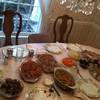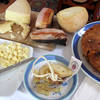Can You Imagine a World Without Nutella?
If you asked an Italian what “Nutella” is, he will probably come up with a number of different answers, according to his age, genre, social extraction, and life style.
“It’s the perfect pairing with a warm slice of bread in the morning”, a mother of a child would probably answer. Or, it’s a midnight “relief” for the deepest heartaches for young teenagers that would eat the whole jar with the help of a teaspoon... or also is a mid-afternoon snack for children who need energy to play sports or with their pals.
Sure enough, its inventor Pietro Ferrero would have never imagined that this product he invented in the 1940s would have conquered first the entire country and then Europe... and now finally the US!
Believe it or not, in fact, Nutella is finally becoming popular in the country where peanut butter has always dominated the kitchen cabinets of every household and the taste of every kid from Massachusetts all the way to Alabama.
If you asked today the average American if he would rather have a Nutella or a peanut butter sandwich, he would have to think about it, while just ten years ago he would have definitely chosen the second option.
There could not have been a better moment for Italian journalist Gigi Padovani and his wife Clara, writer and expert on culinary history, to come up with the new, updated version of their book “Passione Nutella”, that was first released in Italy in 2006.
The first edition of the book features a full catalogue of recipes, including 30 provided by prestigious names of the Italian food industry such as Massimo Bottura and Moreno Cedroni and 40 revisited by Clara herself, a collection that makes this manual a precious guide for all those who view Nutella not only as a spread, but as a potentially precious additional ingredient to traditional and modern, local and national Italian dishes and desserts. “I included recipes that come from every single part of Italy: there are the cantucci from Tuscany, tegole from Val D’Aosta, and amaretti from Piedmont.... There are also more internationally famous recipes such as plum cakes, muffins, or Bavarian cakes. They all have that hint of Nutella that makes them different,” said Clara when she came to visit us this summer at our headquarters, together with her husband Gigi.
“The new edition of the book, which will also be published in English, will have a large introduction focused on the history of Nutella, an updated ‘Nutella dictionary’, and will be the result of a rich collaboration with New York chefs who are very well known both in Italy and the US, among whom are Tony May, Cesare Casella, Lidia Bastianich, Jimmy Bradley, and Jonathan Waxman”.
The book published in 2006 was not the first Nutella book for the couple. Mr. Padovani had already talked about the social and cultural role that Nutella has had in these last decades of Italian history in “Nutella. Un mito italiano”, released in 2004, on the occasion of the 40th anniversary of its first creation.
If Nutella is becoming popular only in these recent years in the US, the label Ferrero is not new to the US market. It was in 1969 when Ferrero U.S.A., Inc. first opened for business in New York City. To introduce the Ferrero story in the vast and unique U.S. market, Ferrero U.S.A., Inc. chose as its lead product, not the enormous Nutella brand or one of the hugely successful Ferrero chocolates, but rather the smallest Ferrero wonder of all - Tic Tac!
The distinctive Tic Tac green was followed by the dazzling gold of Ferrero Rocher, the fine chocolate and hazelnut "praline." Now that Rocher is rapidly becoming a mainstay of increasingly-sophisticated American tastes, consumers are now beginning to enjoy the distinctive taste of Nutella spread. As it rapidly gains distribution and awareness across the U.S., it's destined to become as big a success here as it already is in Europe.
Ferrero today produces about 25,000 miles of jars of Nutella a year, a length that is equal to the entire circumference of the earth! However, despite having become a multinational company, Ferrero, now at its third generation, is still growing under the guidance of the heads of the family: Pietro and Giovanni Ferrero, the grandchildren of founder Pietro, head the Group as its Managing Directors. That gives the company a “glocal” approach (think globally, act locally) to business, being that it focuses on international development, yet adapts to local traditions and needs while giving back to the local community.
The “family structure” is also one of the reasons that brought the Directors not to be part of the Padovanis’ project, “that is not aimed to increase Nutella’s sales, but to offer our consumers a number of ideas of how to use the popular product. The publishing house that commissioned the work, Giunti, obtained the authorization to use the label and pictures that the Ferrero family itself provided us with, but none of the recipes written in the book come from their laboratories. They will give us other, more recent images for the new edition of the book, but once again they will not be involved”, pointed out Clara.
Both Clara and Gigi Padovani come from Alba, the small town in the Piedmont region were the Ferrero company produces Nutella. “All of the residents of Alba breath Nutella right from their first whimper: the perfume of toasted hazelnuts and cocoa fills the air of the entire small town. When you wake up in the morning and open the window, your house gets completely invaded by this aroma, that accompanies you throughout the day. I remember that when I was a junior-high student, I started my days with a cup of warm whole milk and a piece of focaccia with Nutella”, told us Gigi.
Piedmont is the historical capital of chocolate in Italy. It was there that the crema gianduia, the ancestor of Nutella, was first invented in 1866 when Napoleon was defeated by the English Army in Trafalgar and the “Block of Berlin” impeded the arrival of American products in Europe, among which included cocoa. Turin confectioners found out that the aroma of toasted hazelnuts was similar to the one of pure cocoa and invented a new spread, the crema gianduia, to compensate the lack of chocolate in the country. Nutella was invented by Pietro Ferrero following the same principle, when after-WWII Italy was poor and economically destroyed, and there was a consistent demand for something sweet and affordable. La merenda dei bambini ("the kids’ snack", as Pietro Ferrero loved to call it) became a huge success in no time: children of all parts of Italy could get a smear of “Super Crema” on their piece of bread for just 2 liras, and they fell so much in love with it that the ritual of going to the corner store to get their treat became a daily habit.
When in 1964 Pietro’s son, Michele, named the cream “Nutella” from “nut”, he consecrated the product’s international success: “Already in the 1950s he opened factories in different countries of Northern Europe, France and England first of all, and invented a name that could be appealing to those people giving birth to a great marketing strategy in a time when marketing was not even in existence as a practice”.
It’s been about 20 years since Ferrero began producing Nutella in Canada, but only in these last couple years has the product been gaining the favor of American consumers. The advertisement campaign presents it as a breakfast item, underlining its health and nutritional values. As one of the most active members of the Italian branch of the Slow Food movement, Gigi Padovani explained to us that the recent initiative adopted by the European Union Parliament to forbid the Ferrero company to advertise Nutella because it favors obesity and is unhealthy is arguable: “A breakfast with a limited amount of spread on a piece of bread with a glass of juice or milk is balanced and helps you start the day with energy”.
“Nutella will win its battle against peanut butter in America because it is greedier. People need chocolate, are fond of it, and associate great life memories to it. I have never heard of anybody recounting stories related to peanut butter...”, says Clara, whose goal with the new edition of “Passione Nutella” is to teach people the innumerable ways one can use Nutella: that it can become a basic ingredient for both sweet and savory recipes.
Wishing all the best success to the Padovanis and their soon-to-be-published works, we end this piece by quoting Andrea Lee, a journalist for the New Yorker who wrote in an article appearing in 1995 that “defining Nutella as a hazelnut and chocolate spread is like saying that Michelangelo’s David is a huge block of marble”.









































i-Italy
Facebook
Google+
This work may not be reproduced, in whole or in part, without prior written permission.
Questo lavoro non può essere riprodotto, in tutto o in parte, senza permesso scritto.